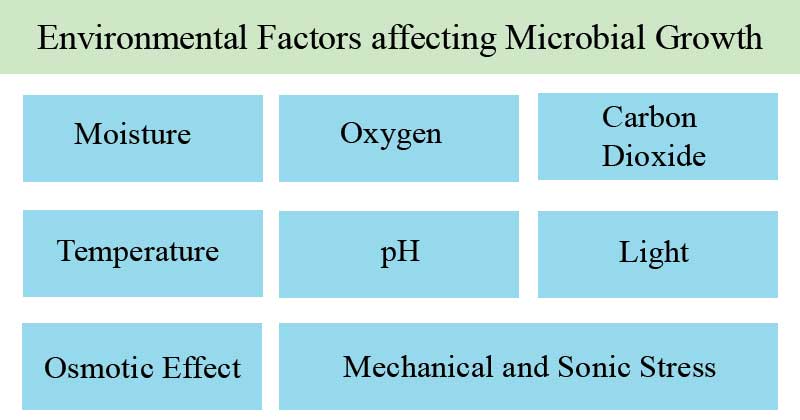

Apart from nutritional components growth of the microbes are also dependent on several environmental factors. These factors play an important role in understanding the growth pattern of a microbe. Apart from that, it is important to understand these factors especially in an industrial set up where a huge amount of biomass is needed.

The environmental factors include:
Water is an essential component for the growth of the bacteria. 80% of the bacterial cell is made up of water. Therefore, the presence of a free water molecule is important for the optimum growth of the microorganism. Apart from that desiccation or drying has a severe effect on microbes. For example Treponema pallidum, N. gonorrhoeae can die easily due to desiccation. While bacterial pathogens like M. tuberculosis, S. aureus can survive desiccation for several weeks. Therefore, it is understood the required moisture content buys the microbe varies species to species. Hence, the moisture content needs to be maintained for optimum growth.
On the basis of requirement of oxygen, bacteria are classified under three groups
On the basis of the bacterial type, the oxygen content is needed to be maintained to acquire optimum growth.
Most of the bacteria require a small amount of carbon dioxide for growth. This carbon dioxide is usually provided by the environment or it can be produced by the bacteria due to cellular metabolism. Organisms such as Brucella abortus require a high level of Carbon dioxide (5-10%) for growth. Bacteria that require a high level of Carbon dioxide for growth are known as capnophilic bacteria.
It is an essential environmental factor that can influence the growth of the organisms. Most of the pathogens grow at 37 0 C (body temperature). Bacteria are categorized under three groups on the basis of the optimum temperature range
pH is an essential factor for the growth of the microbes. May bacteria are able to produce several organic acids which reduce the pH of the medium and also restrict the growth of other bacteria. Apart from that some media constituents can be affected by low pH. Therefore, maintain the optimum pH is highly important to obtain adequate growth of the organisms. Pathogens are mostly requiring neutral pH (7.2). However, industrially important bacteria such as Lactobacillus lactis requires a lower pH for optimum growth.
Phototrophic bacteria require light for the growth. However, most of the bacteria can grow well in darkness. The presence of ultraviolet rays and radiation can reduce bacterial growth. Photochromogenic mycobacterium is a unique species that produce pigments only at the presence of light.
Bacterial cell wall plays an important role in withstanding the osmotic pressure. Plasmolysis (osmotic withdrawal of water leading to shrinkage of protoplasm) can occur if the bacteria are suddenly transferred into a hypertonic solution. On the other hand, if the bacteria are transferred into a concentrated solution palsmoptysis (excessive osmotic imbibitions of water leading to swelling and rupture of the cell) can occur.
The bacterial cell wall provides protection from stress-related issues. However, the cell wall can be ruptured by vigorous shaking with glass beads and by exposure to ultrasonic vibrations.
Textbook of Microbiology by Prof. C.P. Baveja, Arya Publication.
Sources
About Author